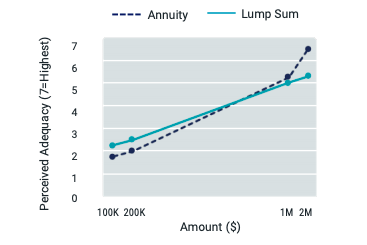Weight Watchers, the iconic American health and wellness giant, filed for…

How Much Income is Enough
Everyone has a different value of a dollar. Regardless of how we view our investments, manage our liabilities, claim our social security benefit, and many other financial decisions, the illusion of wealth is real.
If given the choice of receiving $100,000 at the start of your retirement or $500 per month for the duration of your retirement, which would you choose? What about $200,000 versus $1,000 per month? Which option seems more adequate—the lump sum or monthly amount?
In reality, purchasing an annuity for $100,000 would result in a guaranteed lifetime income of approximately $500 per month, while buying one for $200,000 would yield roughly $1,000 per month. So, these lump sums and annuitized streams are economically equivalent. But are they psychologically equivalent? (Note: As a fee-only fiduciary, CAM earns no fees from any annuity or insurance recommendations).
Perceptions of Wealth: Lump Sum Versus Monthly Income
Behavioral science researchers Hal Hershfield, Dan Goldstein, and Shlomo Benartzi have investigated this question in several studies involving thousands of middle-aged adults (approximate ages 40-60) with varying incomes, educational levels, and ethnicities. In one study, for example, they asked a group of people if they thought $100,000, $200,000, $1 million or $2 million would be adequate to fund their retirement years. To keep things well controlled, they told them to imagine that each sum represented the total amount of money they would have to spend in retirement. The researchers then asked a separate research group how adequate these same amounts would be as monthly income of $500, $1,000, $2,000 and $4,000.
Not surprisingly, as the following figure shows, a lump sum of $100,000 didn’t rate very high on perceived adequacy. Their research participants gave it roughly a 2.25 on a 1-7 scale (where 7 represented “totally adequate”). But participants didn’t think about $500 per month in the same way. That amount garnered roughly a 1.75 on our seven-point scale. And the same was true for the $200,000 lump sum (which averaged a 2.5 rating) and the annuity of $1,000 per month (which rated a 2).
Perceived Adequacy (Between Subjects) of Amounts of Money in 401(k) Plan

Source: Goldstein, Hershfield, and Benartzi, 2016.
Annuity Income May Boost Saving Intentions
Although lump sums and their equivalent monthly amounts are financially the same, they are not psychologically equivalent. At times, lump sums may seem like they are worth more than their resulting annuitized streams. This matters for more than just simple perceptions of adequacy. When offered a $200,000 lump sum versus an equivalent $1,000 monthly annuity, research participants in another study were more motivated to increase their retirement savings (in a hypothetical context) when seeing the annuity compared to the lump sum. In other words, the $1,000 monthly annuity seemed less adequate and therefore boosted savings intentions.
But the story isn’t quite so simple. Yes, lump sums may sometimes seem more adequate than their annuitized streams. But look what happens when we asked people about the adequacy of a $2 million lump sum versus an annuity of $4,000 per month—the annuity seemed more adequate than the lump sum.
Annuities Become More Attractive When Amounts Are Larger
What’s going on here? When people think about how much money they’ll have for the future, more money will always seem better. But the mode of distribution—a lump sum or a monthly amount—will change perceptions of that wealth. From mortgages to car payments to credit card statements, we typically have more experience dealing with monthly amounts of money and whether a given amount will cover our expenses on a monthly basis.
As a result, it appears that people are more sensitive to changes in wealth expressed in monthly terms. This sensitivity can set up an interesting situation in which people perceive monthly amounts as less attractive than lump sums at lower levels of wealth (e.g., $100,000 lump sum versus $500 monthly). At lower levels of wealth, people can more accurately judge just how little a given amount would get them. We call this situation the “illusion of wealth.” Yet, people see monthly sums as more attractive at higher levels of wealth (e.g., $2 million lump sum versus $4,000 monthly income) where people can more accurately judge just how much a higher amount would buy them, or the reversal of the illusion of wealth.
These illusions can affect other financial decisions as well. Claiming Social Security benefits early, for example, results in slightly lower monthly payments over the course of retirement. When the earliest claiming age was 62, workers would forego $119 per month if they claimed benefits at 62 compared to 63. Over time, however, that same amount in lump-sum form would be equal to about $21,492. The illusion of wealth would suggest that the $21,492 lump sum seems larger and therefore a more painful amount to give up compared to the $119 monthly payment.
But it’s not just large decisions like retirement claiming age that are relevant. Consider the case of liabilities. Focusing on small monthly payments spread out over time can have detrimental effects on overall financial well-being if we simultaneously ignore the effects of compounding interest.
Numbers in Isolation Probably Don’t Provide Enough Information
Taken together, we might be better served to question the format that we use when we consider a variety of important financial decisions. Each number—whether it is a monthly amount or a lump sum—is probably not sufficient to use as the basis for a well-informed decision. Rather, when making saving, spending, and investment decisions, we are likely better served by having an understanding of both the sum and its broken-out parts.
Because these decisions can have such a significant impact on one’s current financial planning or longevity planning assumptions, we believe a greater understanding for investors is deserved in order to maximize their well-being for the future.
As always we are here to help.
Best,
Marc
Source: Hal Hershfield, Ph.D., Associate Professor of Marketing and Behavioral Decision Making in the Anderson School of Management at the University of California, Los Angeles; Avantis Investors; M & A Consulting Group, LLC, doing business as CAM Investor Solutions is an SEC-registered investment adviser. As a fee-only firm, we do not receive commissions nor sell any insurance products. We provide financial planning and investment information that we believe to be useful and accurate. However, there cannot be any guarantees. This blog has been provided solely for informational purposes and does not represent investment advice or provide an opinion regarding fairness of any transaction. It does not constitute an offer, solicitation or a recommendation to buy or sell any particular security or instrument or to adopt any investment strategy. Any stated performance does not reflect the expenses associated with the management of an actual portfolio. Past performance is not a guarantee of future results. Diversification does not eliminate the risk of market loss. Charts and graphs provided herein are for illustrative purposes only. There are many different interpretations of investment statistics and many different ideas about how to best use them. Nothing in this presentation should be interpreted to state or imply that past results are an indication of future performance. Tax planning and investment illustrations are provided for educational purposes and should not be considered tax advice or recommendations. Investors should seek additional advice from their financial advisor or tax professional.



